Improving Business Communication: A Report on Little Bus Company
VerifiedAdded on 2023/01/13
|9
|2093
|66
Report
AI Summary
This report provides an analysis of business communication strategies employed by the Little Bus Company. It begins with an abstract outlining the report's focus on improving communication through new policies and the application of communication theories. The report then delves into a literature review, followed by an analysis and discussion section that describes the purposes and principles of organizational communication, differentiating between formal and informal communication channels. It explores the application of effective communication principles, such as clarity, consistency, and informality, to enhance practices. The report also evaluates communication practices for both managers and employees, offering recommendations for improvement, including training, technology adoption, and open-door policies. The conclusion emphasizes the importance of formal communication and training for improving communication skills. References to relevant books and journals are provided at the end of the report. The document is contributed by a student to be published on the website Desklib. Desklib is a platform which provides all the necessary AI based study tools for students.
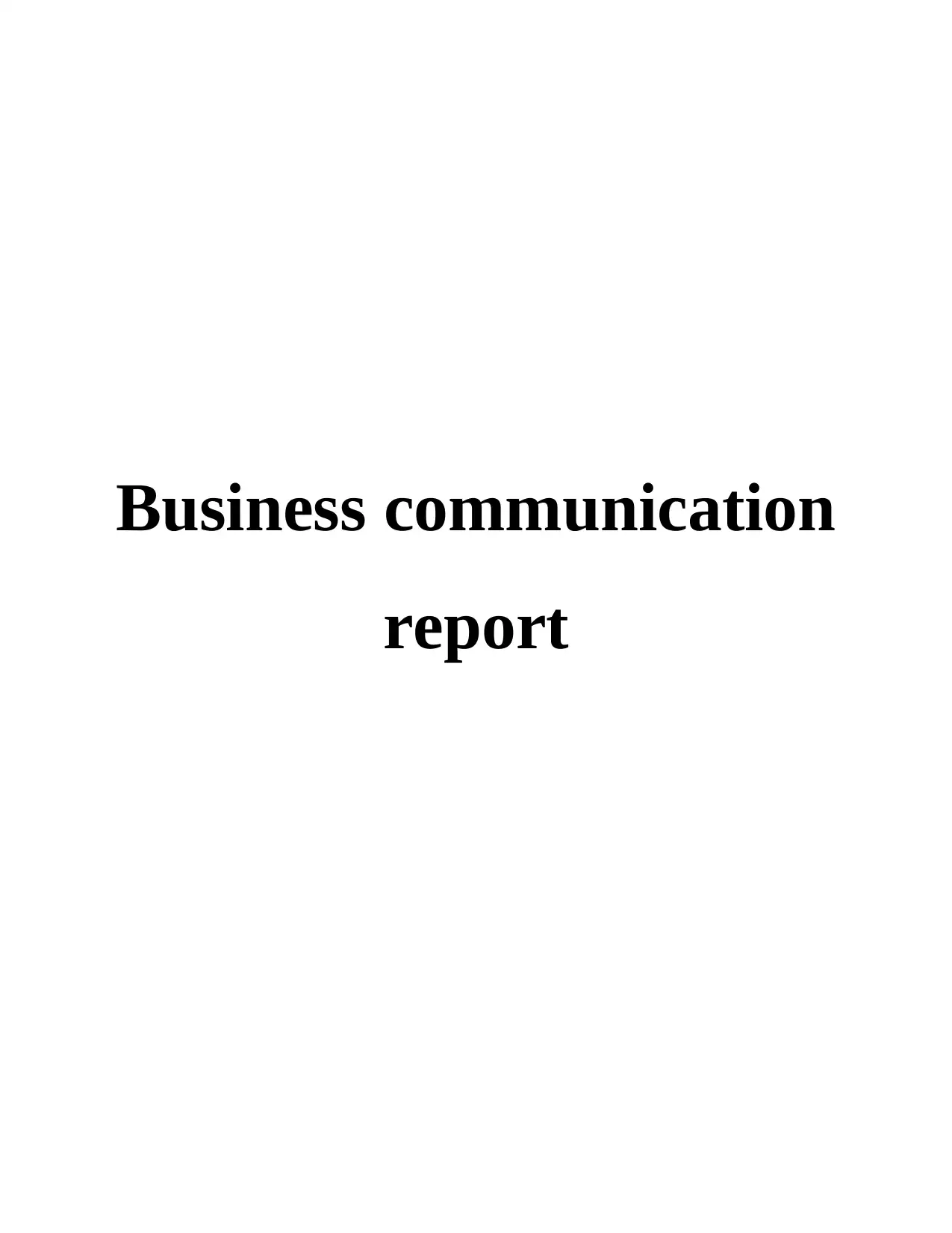
Business communication
report
report
Paraphrase This Document
Need a fresh take? Get an instant paraphrase of this document with our AI Paraphraser
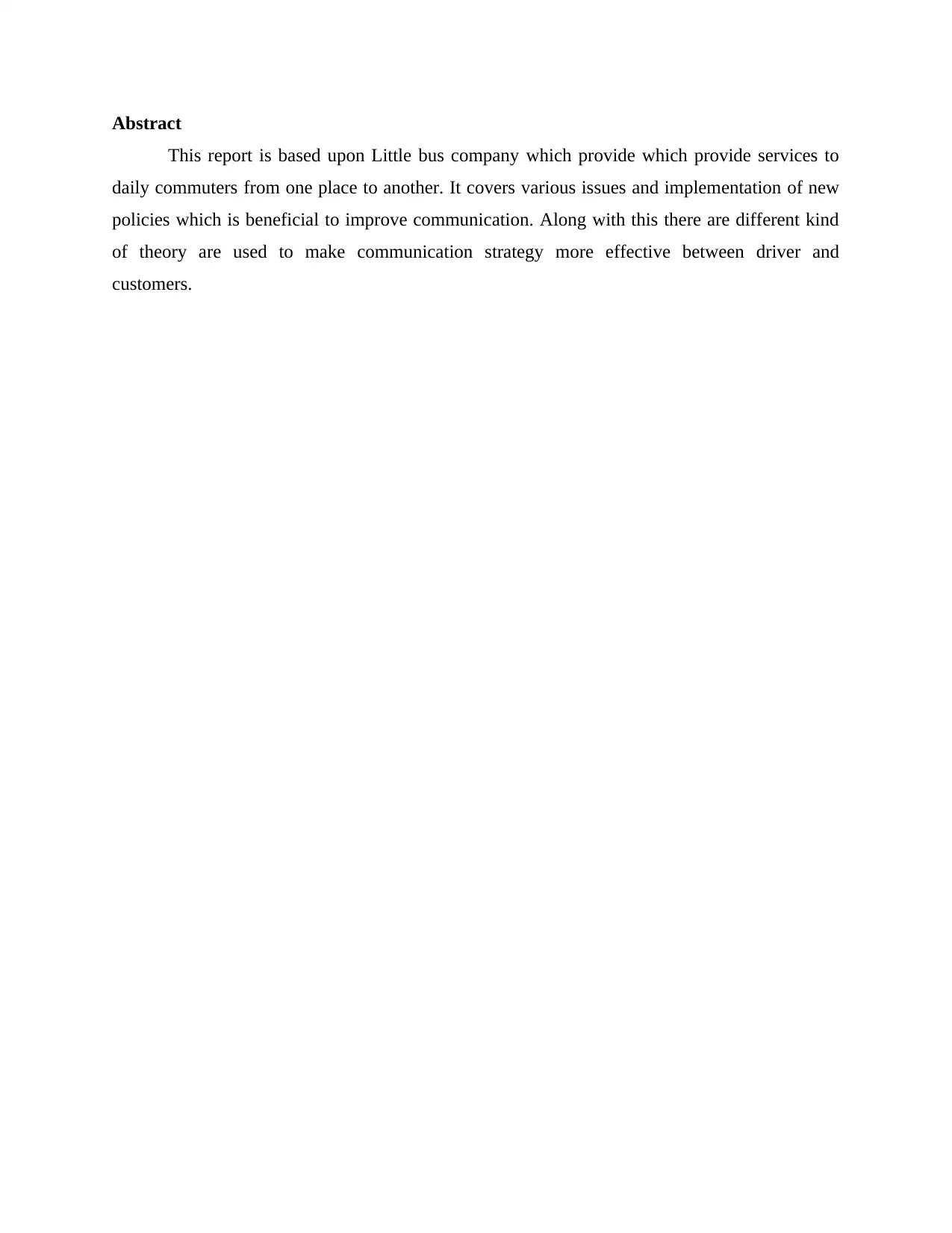
Abstract
This report is based upon Little bus company which provide which provide services to
daily commuters from one place to another. It covers various issues and implementation of new
policies which is beneficial to improve communication. Along with this there are different kind
of theory are used to make communication strategy more effective between driver and
customers.
This report is based upon Little bus company which provide which provide services to
daily commuters from one place to another. It covers various issues and implementation of new
policies which is beneficial to improve communication. Along with this there are different kind
of theory are used to make communication strategy more effective between driver and
customers.

Table of Contents
INTRODUCTION...........................................................................................................................4
Literature review: ............................................................................................................................4
Analysis and discussion ..................................................................................................................4
Describe and analyse the purpose and principles behind different kind of organisational
communication ..........................................................................................................................4
Apply different principles of effective communication in order to enhance practises...............5
Evaluate the effective communication practises for themselves and others...............................6
RECOMMENDATIONS.................................................................................................................7
CONCLUSION................................................................................................................................8
REFERENCES................................................................................................................................1
INTRODUCTION...........................................................................................................................4
Literature review: ............................................................................................................................4
Analysis and discussion ..................................................................................................................4
Describe and analyse the purpose and principles behind different kind of organisational
communication ..........................................................................................................................4
Apply different principles of effective communication in order to enhance practises...............5
Evaluate the effective communication practises for themselves and others...............................6
RECOMMENDATIONS.................................................................................................................7
CONCLUSION................................................................................................................................8
REFERENCES................................................................................................................................1
⊘ This is a preview!⊘
Do you want full access?
Subscribe today to unlock all pages.

Trusted by 1+ million students worldwide
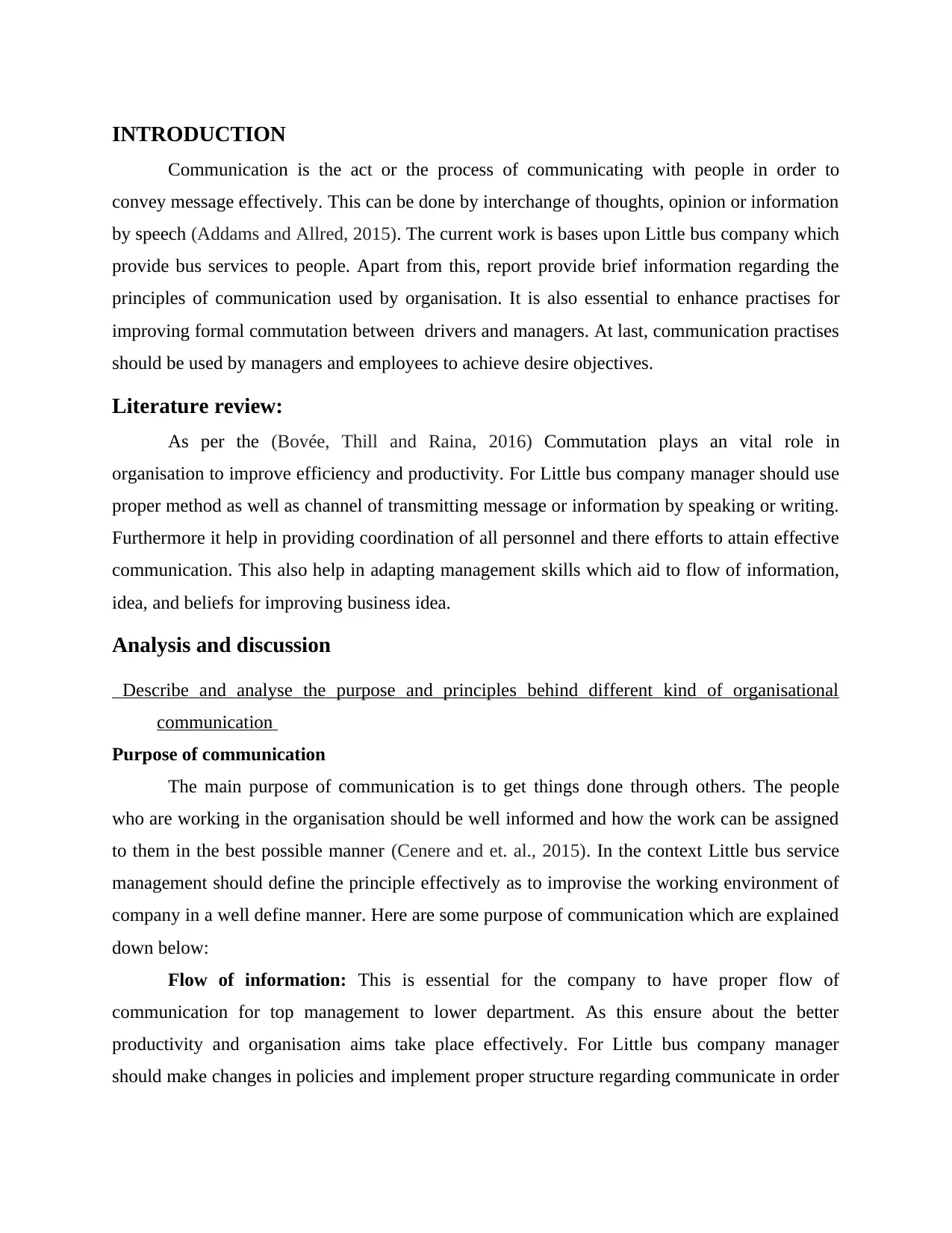
INTRODUCTION
Communication is the act or the process of communicating with people in order to
convey message effectively. This can be done by interchange of thoughts, opinion or information
by speech (Addams and Allred, 2015). The current work is bases upon Little bus company which
provide bus services to people. Apart from this, report provide brief information regarding the
principles of communication used by organisation. It is also essential to enhance practises for
improving formal commutation between drivers and managers. At last, communication practises
should be used by managers and employees to achieve desire objectives.
Literature review:
As per the (Bovée, Thill and Raina, 2016) Commutation plays an vital role in
organisation to improve efficiency and productivity. For Little bus company manager should use
proper method as well as channel of transmitting message or information by speaking or writing.
Furthermore it help in providing coordination of all personnel and there efforts to attain effective
communication. This also help in adapting management skills which aid to flow of information,
idea, and beliefs for improving business idea.
Analysis and discussion
Describe and analyse the purpose and principles behind different kind of organisational
communication
Purpose of communication
The main purpose of communication is to get things done through others. The people
who are working in the organisation should be well informed and how the work can be assigned
to them in the best possible manner (Cenere and et. al., 2015). In the context Little bus service
management should define the principle effectively as to improvise the working environment of
company in a well define manner. Here are some purpose of communication which are explained
down below:
Flow of information: This is essential for the company to have proper flow of
communication for top management to lower department. As this ensure about the better
productivity and organisation aims take place effectively. For Little bus company manager
should make changes in policies and implement proper structure regarding communicate in order
Communication is the act or the process of communicating with people in order to
convey message effectively. This can be done by interchange of thoughts, opinion or information
by speech (Addams and Allred, 2015). The current work is bases upon Little bus company which
provide bus services to people. Apart from this, report provide brief information regarding the
principles of communication used by organisation. It is also essential to enhance practises for
improving formal commutation between drivers and managers. At last, communication practises
should be used by managers and employees to achieve desire objectives.
Literature review:
As per the (Bovée, Thill and Raina, 2016) Commutation plays an vital role in
organisation to improve efficiency and productivity. For Little bus company manager should use
proper method as well as channel of transmitting message or information by speaking or writing.
Furthermore it help in providing coordination of all personnel and there efforts to attain effective
communication. This also help in adapting management skills which aid to flow of information,
idea, and beliefs for improving business idea.
Analysis and discussion
Describe and analyse the purpose and principles behind different kind of organisational
communication
Purpose of communication
The main purpose of communication is to get things done through others. The people
who are working in the organisation should be well informed and how the work can be assigned
to them in the best possible manner (Cenere and et. al., 2015). In the context Little bus service
management should define the principle effectively as to improvise the working environment of
company in a well define manner. Here are some purpose of communication which are explained
down below:
Flow of information: This is essential for the company to have proper flow of
communication for top management to lower department. As this ensure about the better
productivity and organisation aims take place effectively. For Little bus company manager
should make changes in policies and implement proper structure regarding communicate in order
Paraphrase This Document
Need a fresh take? Get an instant paraphrase of this document with our AI Paraphraser
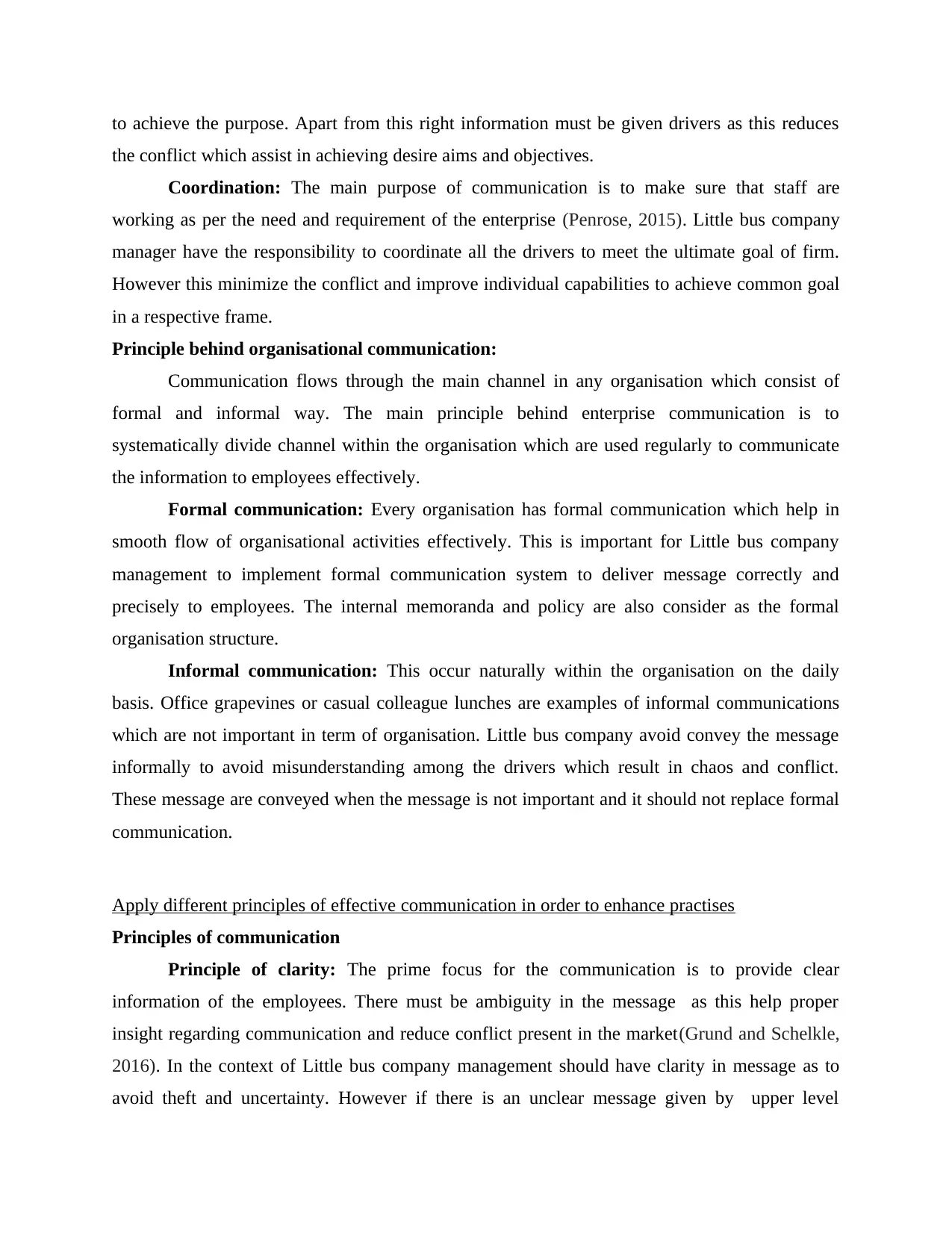
to achieve the purpose. Apart from this right information must be given drivers as this reduces
the conflict which assist in achieving desire aims and objectives.
Coordination: The main purpose of communication is to make sure that staff are
working as per the need and requirement of the enterprise (Penrose, 2015). Little bus company
manager have the responsibility to coordinate all the drivers to meet the ultimate goal of firm.
However this minimize the conflict and improve individual capabilities to achieve common goal
in a respective frame.
Principle behind organisational communication:
Communication flows through the main channel in any organisation which consist of
formal and informal way. The main principle behind enterprise communication is to
systematically divide channel within the organisation which are used regularly to communicate
the information to employees effectively.
Formal communication: Every organisation has formal communication which help in
smooth flow of organisational activities effectively. This is important for Little bus company
management to implement formal communication system to deliver message correctly and
precisely to employees. The internal memoranda and policy are also consider as the formal
organisation structure.
Informal communication: This occur naturally within the organisation on the daily
basis. Office grapevines or casual colleague lunches are examples of informal communications
which are not important in term of organisation. Little bus company avoid convey the message
informally to avoid misunderstanding among the drivers which result in chaos and conflict.
These message are conveyed when the message is not important and it should not replace formal
communication.
Apply different principles of effective communication in order to enhance practises
Principles of communication
Principle of clarity: The prime focus for the communication is to provide clear
information of the employees. There must be ambiguity in the message as this help proper
insight regarding communication and reduce conflict present in the market(Grund and Schelkle,
2016). In the context of Little bus company management should have clarity in message as to
avoid theft and uncertainty. However if there is an unclear message given by upper level
the conflict which assist in achieving desire aims and objectives.
Coordination: The main purpose of communication is to make sure that staff are
working as per the need and requirement of the enterprise (Penrose, 2015). Little bus company
manager have the responsibility to coordinate all the drivers to meet the ultimate goal of firm.
However this minimize the conflict and improve individual capabilities to achieve common goal
in a respective frame.
Principle behind organisational communication:
Communication flows through the main channel in any organisation which consist of
formal and informal way. The main principle behind enterprise communication is to
systematically divide channel within the organisation which are used regularly to communicate
the information to employees effectively.
Formal communication: Every organisation has formal communication which help in
smooth flow of organisational activities effectively. This is important for Little bus company
management to implement formal communication system to deliver message correctly and
precisely to employees. The internal memoranda and policy are also consider as the formal
organisation structure.
Informal communication: This occur naturally within the organisation on the daily
basis. Office grapevines or casual colleague lunches are examples of informal communications
which are not important in term of organisation. Little bus company avoid convey the message
informally to avoid misunderstanding among the drivers which result in chaos and conflict.
These message are conveyed when the message is not important and it should not replace formal
communication.
Apply different principles of effective communication in order to enhance practises
Principles of communication
Principle of clarity: The prime focus for the communication is to provide clear
information of the employees. There must be ambiguity in the message as this help proper
insight regarding communication and reduce conflict present in the market(Grund and Schelkle,
2016). In the context of Little bus company management should have clarity in message as to
avoid theft and uncertainty. However if there is an unclear message given by upper level
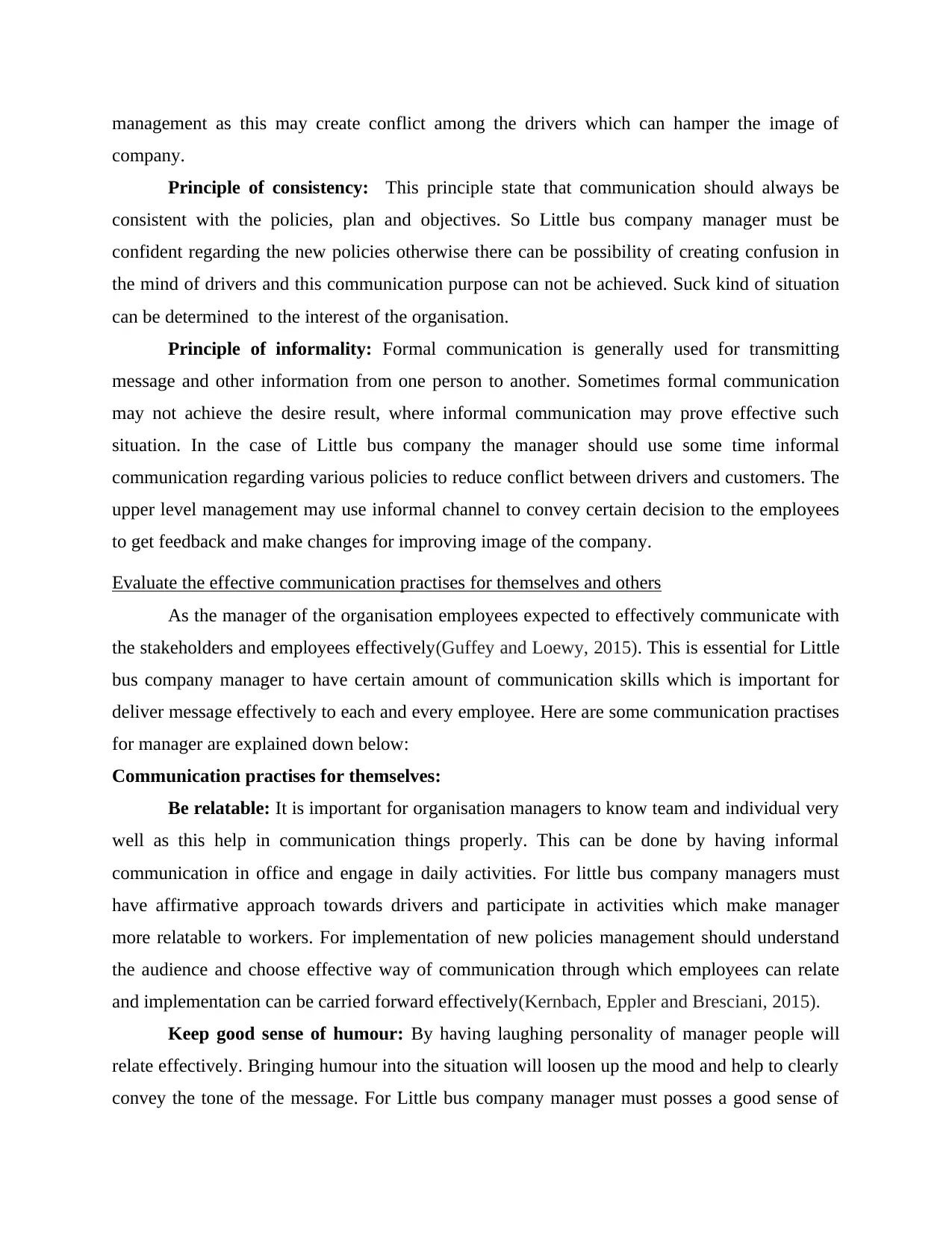
management as this may create conflict among the drivers which can hamper the image of
company.
Principle of consistency: This principle state that communication should always be
consistent with the policies, plan and objectives. So Little bus company manager must be
confident regarding the new policies otherwise there can be possibility of creating confusion in
the mind of drivers and this communication purpose can not be achieved. Suck kind of situation
can be determined to the interest of the organisation.
Principle of informality: Formal communication is generally used for transmitting
message and other information from one person to another. Sometimes formal communication
may not achieve the desire result, where informal communication may prove effective such
situation. In the case of Little bus company the manager should use some time informal
communication regarding various policies to reduce conflict between drivers and customers. The
upper level management may use informal channel to convey certain decision to the employees
to get feedback and make changes for improving image of the company.
Evaluate the effective communication practises for themselves and others
As the manager of the organisation employees expected to effectively communicate with
the stakeholders and employees effectively(Guffey and Loewy, 2015). This is essential for Little
bus company manager to have certain amount of communication skills which is important for
deliver message effectively to each and every employee. Here are some communication practises
for manager are explained down below:
Communication practises for themselves:
Be relatable: It is important for organisation managers to know team and individual very
well as this help in communication things properly. This can be done by having informal
communication in office and engage in daily activities. For little bus company managers must
have affirmative approach towards drivers and participate in activities which make manager
more relatable to workers. For implementation of new policies management should understand
the audience and choose effective way of communication through which employees can relate
and implementation can be carried forward effectively(Kernbach, Eppler and Bresciani, 2015).
Keep good sense of humour: By having laughing personality of manager people will
relate effectively. Bringing humour into the situation will loosen up the mood and help to clearly
convey the tone of the message. For Little bus company manager must posses a good sense of
company.
Principle of consistency: This principle state that communication should always be
consistent with the policies, plan and objectives. So Little bus company manager must be
confident regarding the new policies otherwise there can be possibility of creating confusion in
the mind of drivers and this communication purpose can not be achieved. Suck kind of situation
can be determined to the interest of the organisation.
Principle of informality: Formal communication is generally used for transmitting
message and other information from one person to another. Sometimes formal communication
may not achieve the desire result, where informal communication may prove effective such
situation. In the case of Little bus company the manager should use some time informal
communication regarding various policies to reduce conflict between drivers and customers. The
upper level management may use informal channel to convey certain decision to the employees
to get feedback and make changes for improving image of the company.
Evaluate the effective communication practises for themselves and others
As the manager of the organisation employees expected to effectively communicate with
the stakeholders and employees effectively(Guffey and Loewy, 2015). This is essential for Little
bus company manager to have certain amount of communication skills which is important for
deliver message effectively to each and every employee. Here are some communication practises
for manager are explained down below:
Communication practises for themselves:
Be relatable: It is important for organisation managers to know team and individual very
well as this help in communication things properly. This can be done by having informal
communication in office and engage in daily activities. For little bus company managers must
have affirmative approach towards drivers and participate in activities which make manager
more relatable to workers. For implementation of new policies management should understand
the audience and choose effective way of communication through which employees can relate
and implementation can be carried forward effectively(Kernbach, Eppler and Bresciani, 2015).
Keep good sense of humour: By having laughing personality of manager people will
relate effectively. Bringing humour into the situation will loosen up the mood and help to clearly
convey the tone of the message. For Little bus company manager must posses a good sense of
⊘ This is a preview!⊘
Do you want full access?
Subscribe today to unlock all pages.

Trusted by 1+ million students worldwide
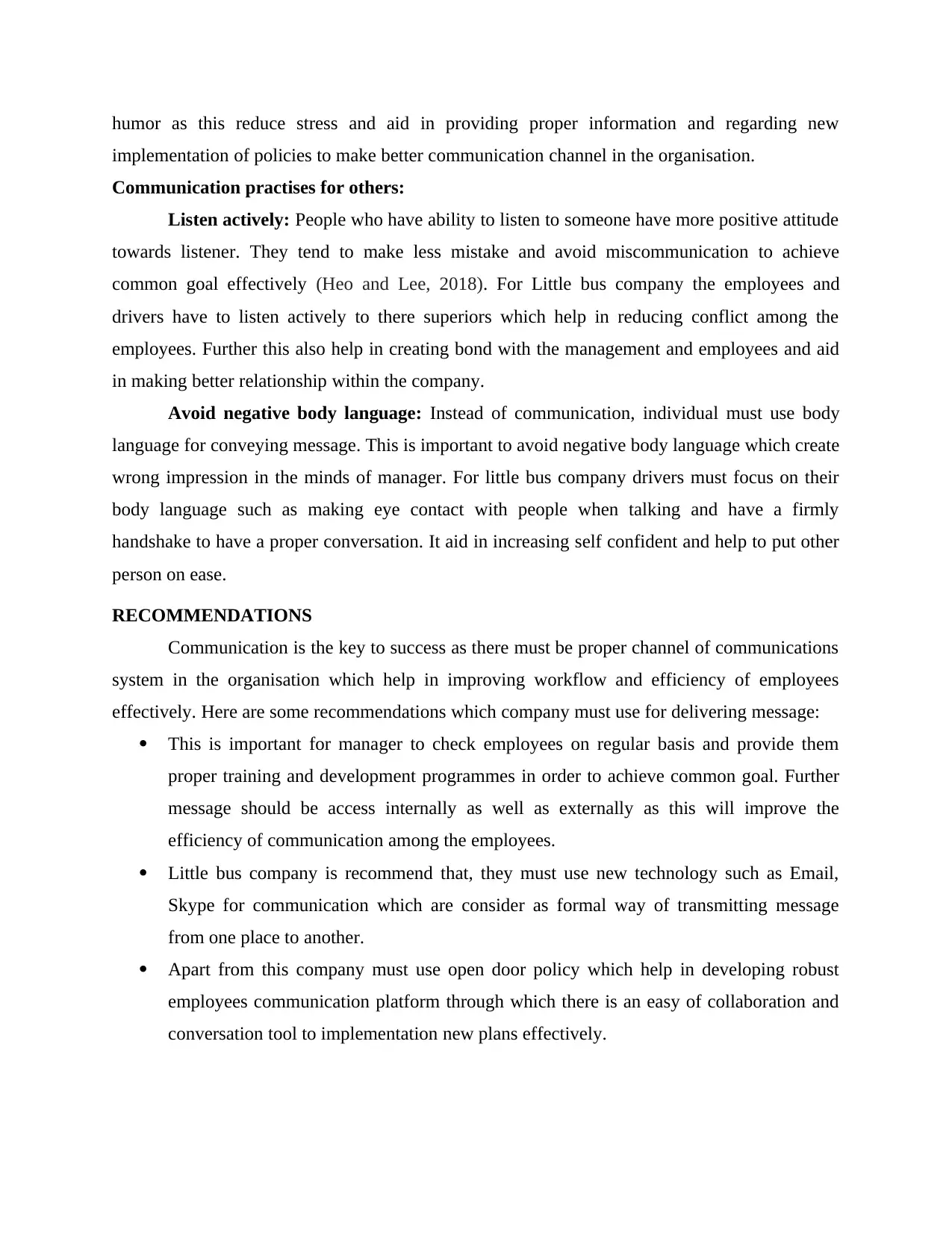
humor as this reduce stress and aid in providing proper information and regarding new
implementation of policies to make better communication channel in the organisation.
Communication practises for others:
Listen actively: People who have ability to listen to someone have more positive attitude
towards listener. They tend to make less mistake and avoid miscommunication to achieve
common goal effectively (Heo and Lee, 2018). For Little bus company the employees and
drivers have to listen actively to there superiors which help in reducing conflict among the
employees. Further this also help in creating bond with the management and employees and aid
in making better relationship within the company.
Avoid negative body language: Instead of communication, individual must use body
language for conveying message. This is important to avoid negative body language which create
wrong impression in the minds of manager. For little bus company drivers must focus on their
body language such as making eye contact with people when talking and have a firmly
handshake to have a proper conversation. It aid in increasing self confident and help to put other
person on ease.
RECOMMENDATIONS
Communication is the key to success as there must be proper channel of communications
system in the organisation which help in improving workflow and efficiency of employees
effectively. Here are some recommendations which company must use for delivering message:
This is important for manager to check employees on regular basis and provide them
proper training and development programmes in order to achieve common goal. Further
message should be access internally as well as externally as this will improve the
efficiency of communication among the employees.
Little bus company is recommend that, they must use new technology such as Email,
Skype for communication which are consider as formal way of transmitting message
from one place to another.
Apart from this company must use open door policy which help in developing robust
employees communication platform through which there is an easy of collaboration and
conversation tool to implementation new plans effectively.
implementation of policies to make better communication channel in the organisation.
Communication practises for others:
Listen actively: People who have ability to listen to someone have more positive attitude
towards listener. They tend to make less mistake and avoid miscommunication to achieve
common goal effectively (Heo and Lee, 2018). For Little bus company the employees and
drivers have to listen actively to there superiors which help in reducing conflict among the
employees. Further this also help in creating bond with the management and employees and aid
in making better relationship within the company.
Avoid negative body language: Instead of communication, individual must use body
language for conveying message. This is important to avoid negative body language which create
wrong impression in the minds of manager. For little bus company drivers must focus on their
body language such as making eye contact with people when talking and have a firmly
handshake to have a proper conversation. It aid in increasing self confident and help to put other
person on ease.
RECOMMENDATIONS
Communication is the key to success as there must be proper channel of communications
system in the organisation which help in improving workflow and efficiency of employees
effectively. Here are some recommendations which company must use for delivering message:
This is important for manager to check employees on regular basis and provide them
proper training and development programmes in order to achieve common goal. Further
message should be access internally as well as externally as this will improve the
efficiency of communication among the employees.
Little bus company is recommend that, they must use new technology such as Email,
Skype for communication which are consider as formal way of transmitting message
from one place to another.
Apart from this company must use open door policy which help in developing robust
employees communication platform through which there is an easy of collaboration and
conversation tool to implementation new plans effectively.
Paraphrase This Document
Need a fresh take? Get an instant paraphrase of this document with our AI Paraphraser
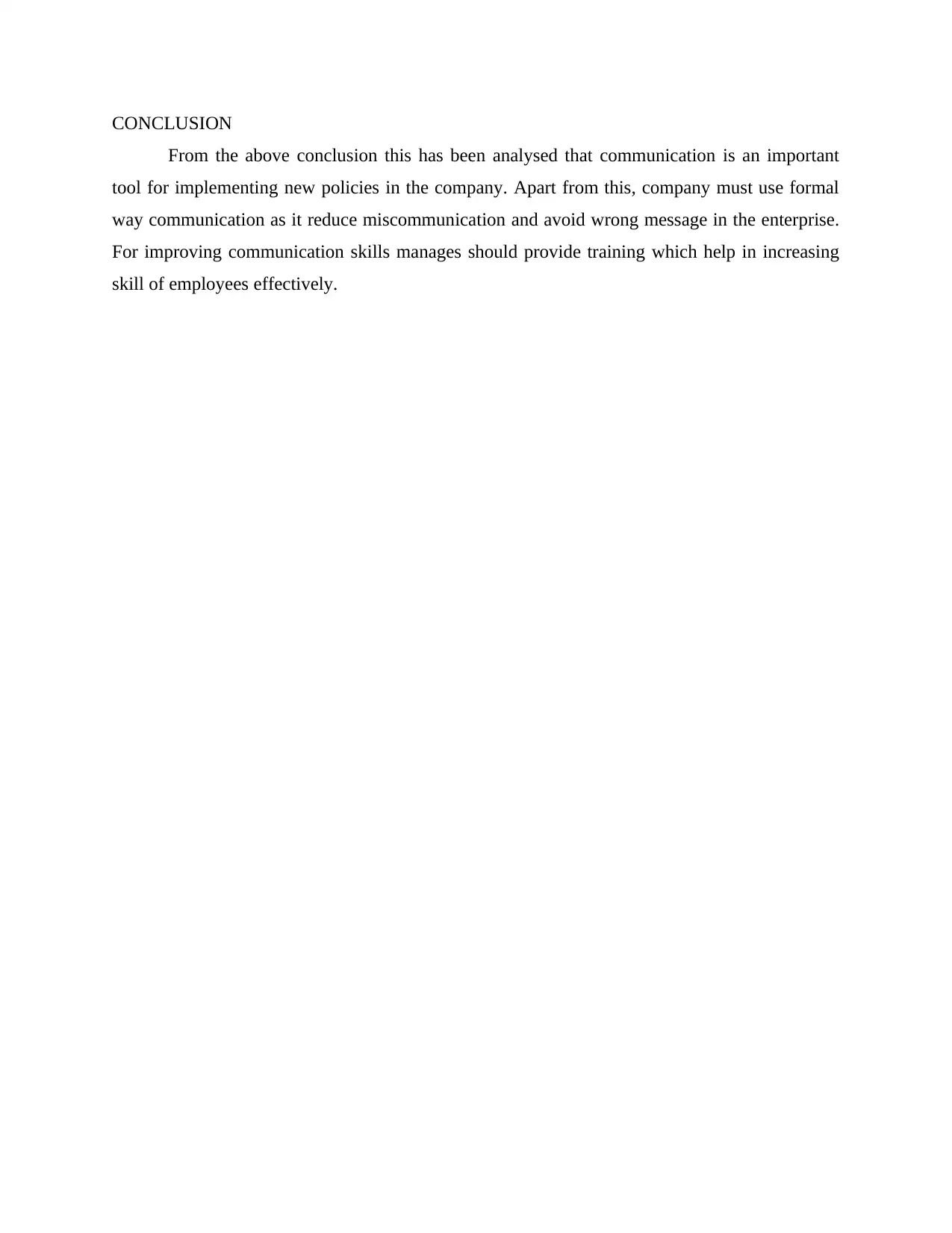
CONCLUSION
From the above conclusion this has been analysed that communication is an important
tool for implementing new policies in the company. Apart from this, company must use formal
way communication as it reduce miscommunication and avoid wrong message in the enterprise.
For improving communication skills manages should provide training which help in increasing
skill of employees effectively.
From the above conclusion this has been analysed that communication is an important
tool for implementing new policies in the company. Apart from this, company must use formal
way communication as it reduce miscommunication and avoid wrong message in the enterprise.
For improving communication skills manages should provide training which help in increasing
skill of employees effectively.
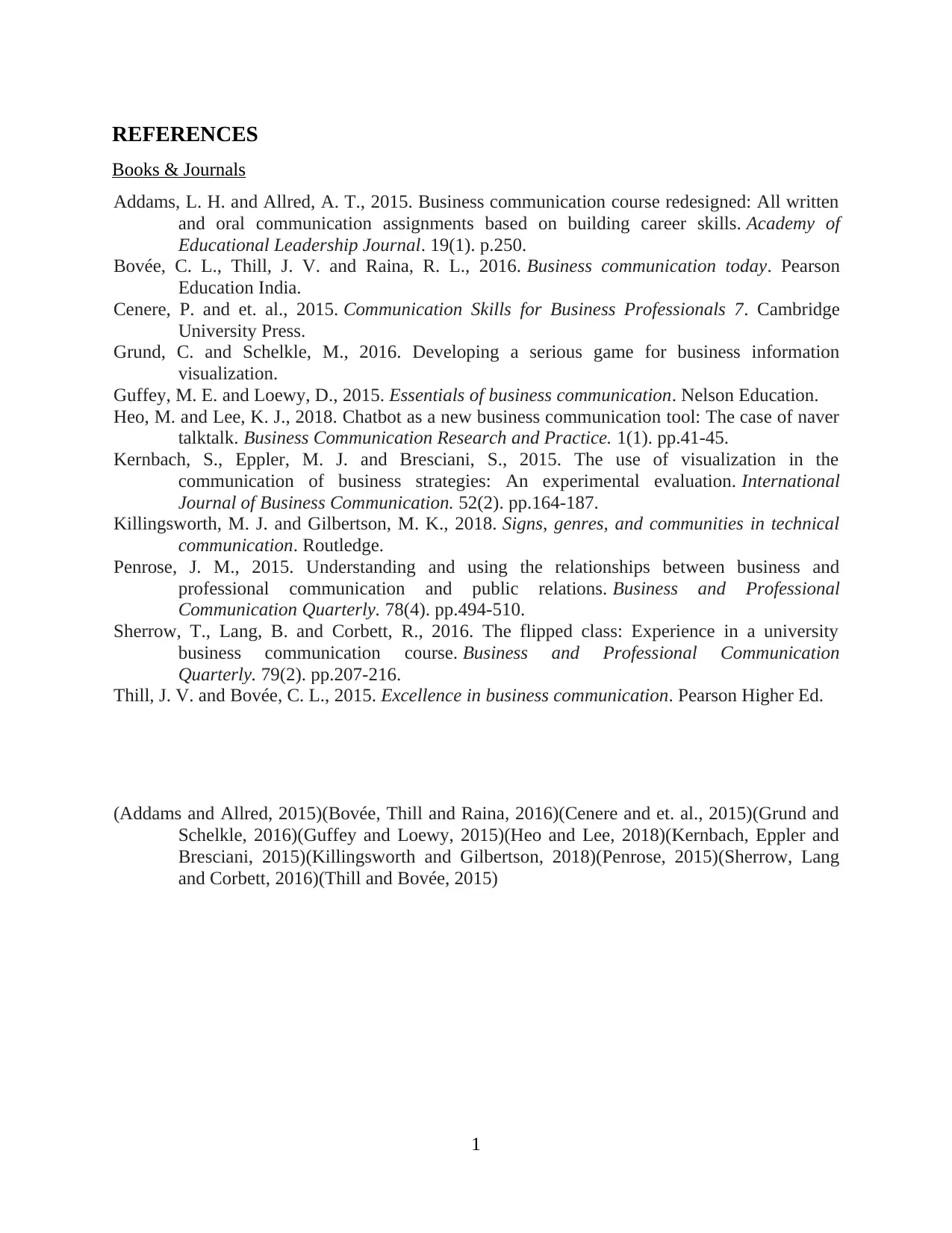
REFERENCES
Books & Journals
Addams, L. H. and Allred, A. T., 2015. Business communication course redesigned: All written
and oral communication assignments based on building career skills. Academy of
Educational Leadership Journal. 19(1). p.250.
Bovée, C. L., Thill, J. V. and Raina, R. L., 2016. Business communication today. Pearson
Education India.
Cenere, P. and et. al., 2015. Communication Skills for Business Professionals 7. Cambridge
University Press.
Grund, C. and Schelkle, M., 2016. Developing a serious game for business information
visualization.
Guffey, M. E. and Loewy, D., 2015. Essentials of business communication. Nelson Education.
Heo, M. and Lee, K. J., 2018. Chatbot as a new business communication tool: The case of naver
talktalk. Business Communication Research and Practice. 1(1). pp.41-45.
Kernbach, S., Eppler, M. J. and Bresciani, S., 2015. The use of visualization in the
communication of business strategies: An experimental evaluation. International
Journal of Business Communication. 52(2). pp.164-187.
Killingsworth, M. J. and Gilbertson, M. K., 2018. Signs, genres, and communities in technical
communication. Routledge.
Penrose, J. M., 2015. Understanding and using the relationships between business and
professional communication and public relations. Business and Professional
Communication Quarterly. 78(4). pp.494-510.
Sherrow, T., Lang, B. and Corbett, R., 2016. The flipped class: Experience in a university
business communication course. Business and Professional Communication
Quarterly. 79(2). pp.207-216.
Thill, J. V. and Bovée, C. L., 2015. Excellence in business communication. Pearson Higher Ed.
(Addams and Allred, 2015)(Bovée, Thill and Raina, 2016)(Cenere and et. al., 2015)(Grund and
Schelkle, 2016)(Guffey and Loewy, 2015)(Heo and Lee, 2018)(Kernbach, Eppler and
Bresciani, 2015)(Killingsworth and Gilbertson, 2018)(Penrose, 2015)(Sherrow, Lang
and Corbett, 2016)(Thill and Bovée, 2015)
1
Books & Journals
Addams, L. H. and Allred, A. T., 2015. Business communication course redesigned: All written
and oral communication assignments based on building career skills. Academy of
Educational Leadership Journal. 19(1). p.250.
Bovée, C. L., Thill, J. V. and Raina, R. L., 2016. Business communication today. Pearson
Education India.
Cenere, P. and et. al., 2015. Communication Skills for Business Professionals 7. Cambridge
University Press.
Grund, C. and Schelkle, M., 2016. Developing a serious game for business information
visualization.
Guffey, M. E. and Loewy, D., 2015. Essentials of business communication. Nelson Education.
Heo, M. and Lee, K. J., 2018. Chatbot as a new business communication tool: The case of naver
talktalk. Business Communication Research and Practice. 1(1). pp.41-45.
Kernbach, S., Eppler, M. J. and Bresciani, S., 2015. The use of visualization in the
communication of business strategies: An experimental evaluation. International
Journal of Business Communication. 52(2). pp.164-187.
Killingsworth, M. J. and Gilbertson, M. K., 2018. Signs, genres, and communities in technical
communication. Routledge.
Penrose, J. M., 2015. Understanding and using the relationships between business and
professional communication and public relations. Business and Professional
Communication Quarterly. 78(4). pp.494-510.
Sherrow, T., Lang, B. and Corbett, R., 2016. The flipped class: Experience in a university
business communication course. Business and Professional Communication
Quarterly. 79(2). pp.207-216.
Thill, J. V. and Bovée, C. L., 2015. Excellence in business communication. Pearson Higher Ed.
(Addams and Allred, 2015)(Bovée, Thill and Raina, 2016)(Cenere and et. al., 2015)(Grund and
Schelkle, 2016)(Guffey and Loewy, 2015)(Heo and Lee, 2018)(Kernbach, Eppler and
Bresciani, 2015)(Killingsworth and Gilbertson, 2018)(Penrose, 2015)(Sherrow, Lang
and Corbett, 2016)(Thill and Bovée, 2015)
1
⊘ This is a preview!⊘
Do you want full access?
Subscribe today to unlock all pages.

Trusted by 1+ million students worldwide
1 out of 9
Related Documents
Your All-in-One AI-Powered Toolkit for Academic Success.
+13062052269
info@desklib.com
Available 24*7 on WhatsApp / Email
![[object Object]](/_next/static/media/star-bottom.7253800d.svg)
Unlock your academic potential
Copyright © 2020–2025 A2Z Services. All Rights Reserved. Developed and managed by ZUCOL.





